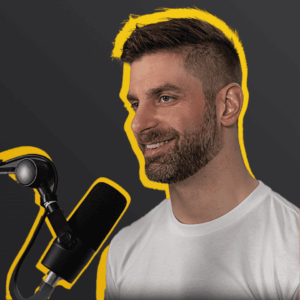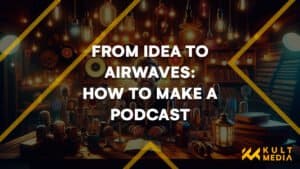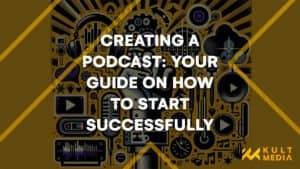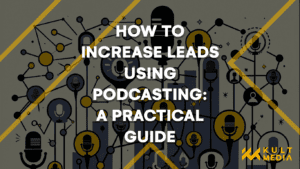Welcome to the KULT Kreator Experience, successful content creation to build powerful connections, a podcast designed to help passionate experts and entrepreneurs launch a podcasting platform, successfully build a following and become industry leaders.
So far in this series, we have covered; why you want to podcast, who your ideal listener is, what your podcast format will be and pre production for podcasts.
In today’s blog, we jump straight into the action. We’re talking about podcasting practicals, recording the show or making your vision become a reality. This is the Production phase of the KULT Kreator Experience and in it, I share detailed information about workflows, recording environments, some podcasting kits, how to practice and performance insights and tips.
And I’m going to avoid making this episode all about audio brands and the supposed best tech for podcast production today. This information quickly becomes outdated and as you will learn, I don’t think it’s as important as social media & Facebook groups might lead you to believe.
But before we enter the studio, turn our phones to airplane mode and step up to the mic, please take a second to follow us on Instagram @kult.media and on your podcasting app of choice.
Workflows
If you have been following this show from the start, you will know that I’m a big fan of planning before we do anything. And so far, we’ve made personal goals, we’ve imagined the target audience, we’ve designed our podcasting product, we’ve utilized pre production to map out our podcasting lifecycle, and now we build our podcast creation workflow. So let’s start with the basics.
Let’s start with the basics. What is a workflow?
“A workflow consists of a coordinated and repeatable pattern of activity, enabled by systems and processes that transform materials, provide services, or process information”
In our case, we take the objective of producing content we break it down into smaller tasks that we can replicate over and over. So for each recording session and interview, there should be a checklist to help you remember everything, be more efficient with time, ensure premium sound quality and allow for delegation.
A good example of a workflow you might have already started to create is your podcast launch strategy. You will have listed all the tasks you need to do to get the show live, artwork, recording & podcast editing, podcast marketing, etc.
So we can utilise all of your hard work in pre-production to create a workflow to suit your podcast.
Now everyone’s podcasting production workflow is going to be different depending on the show format, budget, equipment, and subject matter. This is why I think it is important to write yourself a checklist to see if there are any improvements or something missing. Many podcasting gurus will share their exact workflow, but that is only a workflow that works for them, their podcast show and not your individual needs.
Saying that though, I have produced a series of PodGuides that features a handy podcast production process checklist at the end of the guide. These checklists are the fundamentals that every podcaster should follow not a step by step to my workflow.
Let me share a podcast production workflow I recently created for a client using a Rode Rodecaster Pro set-up. This will give you an idea of what you could include in your production workflow.
- PLUG IN RODECASTER PRO POWER
- CONNECT MICS
- CONNECT HEADPHONES
- CONNECT AUX DEVICES
- INSERT MEMORY CARD
- ————————–
- POWER UP RODECASTER PRO
- SELECT MIC CHANNEL(S)
- ADJUST INPUT LEVEL INTO GREEN MARKERS
- SELECT MIC TYPE (GOLD MIC = CONDENSER)
- SELECT PROCESSING (USUALLY JUST LOWPASS ONLY ON)
- SELECT VOICE PRESET (USUALLY OFF)
- MENU: SETTINGS > CHANNEL
- MENU: SETTINGS > ADVANCED
- CHANNEL FADERS & MONITOR LEVELS SET
- RECORD!
- STOP
- TEST RECORDING – MENU: SETTINGS > PODCASTS
If you need a hand producing your workflow drop me a message on social media or at matt@kult.media
Testing Your Workflow
Now the next step is to test. Yes, that’s right test it.
Honestly, I have worked with podcasters that waited until the recording session to set up their kit. And you guessed it, stuff went wrong.
There was nothing wrong with the workflow we had written, but the kit itself was not performing as it should. And much of it was new too.
So set yourself up for success by getting through some dress rehearsals with your podcast. We will come back to this point a little later.
Delegation
Now I mentioned delegation. Delegation is an important point. Up til now, it has been all about you the Kult Kreator establishing your podcast. But life doesn’t always allow for you alone to spend every minute producing podcasts … must be nice if it does though. Must be very nice!
In fact, I can bet money that there are certain aspects of being a content creator that you will dislike, or even possibly hate!
As a Leader, it is important to know what to delegate and when to get your hands dirty. As you create your podcast keep an eye out for those tasks you love, those that take too much time and the tasks you dislike and dread. We should look to seek help for the latter two.
Delegating or outsourcing is a brilliant way to define a clear workflow. You will need to instruct the third party exactly how they can assist you with your podcast. You know they say never assume, it makes an ass of you and me. So make sure that your instructions or workflow are comprehensive and clear to follow. If you have a thought that something “Should” be obvious or that common sense will be apparent at a certain point, DON’T. Never leave anything to chance or put the person helping you in a position to make a mistake. Look out for red flags like “I think I know to..” or “it’s pretty simple really” even if they say “I’ve done this for someone similar”, just double-check. It will save time and uncomfortable situations.
And if in doubt ask someone. There are lots of communities out there on social media, forums and from coaches. Like me!
Once you have a workflow there are lots of tools and apps to help you manage these tasks. I think it is really important to have some form of project management. It definitely saves on repetition of the tasks that might have already been done and it can make the delegation of tasks far more simple.
This could be a basic spreadsheet, a free PDF checklist from me or sophisticated software that allows for automation and time management.
It is really only about you and your preferences. I use an app called ClickUp to manage my podcast series, and it can do a whole lot more than I use it for. Other apps I’ve used include asana, Trello, Basecamp and notion. All great tools but each with its own features and drawbacks. Maybe I should do an episode just on project management options in the next series?
And one final thing I would like to add to my workflow section … data management. Yes, what you do or do not do with your audio files or video files. If a file is not backed up in at least 3 places … it’s not backed up in my opinion. Consider the best process for you to build in some redundancy to your workflow as insurance against losing your content.
Recording Environment
If you have already downloaded my free Podcast Guides series for creators from the website, you will have seen that one of the points I have made in both the Practical Podcast Checklist and Top Tips To Be The Best Podcast Guest is finding the optimum recording space.
For those that haven’t read the PodGuides here are my prerequisites for the optimum podcast recording space.
Hire a professional recording studio with a sound engineer. LOL not really. Going to a dedicated space or studio for podcasting is strongly recommended but not always possible, and comes at a cost.
So if are at home or in the office we should look for a quiet environment with minimal background noise: No AC, No extraneous noise, No Distractions, and No Public spaces.
We should seek rooms with soft surfaces: Curtains closed, No flat hard reflective surfaces. Smaller rooms can offer less echo. You can Hang some duvets and blankets to reduce echo if you do have a nasty one. Try clapping to hear how sound bounces around the room.
Next, you should be Comfortable: Sit where you are comfy and set up around you, you might be recording for a while. This means bringing the mic to you not the other way around. Your back will thank me.
And if you are filming a video podcast, consider what is in the background. We’ve all seen awkward news clips of people with odd items in the background or kids being kids.
That brings me to mention, to remind those around you that you are recording podcasts. Let the family and co-workers know you are not to be disturbed, keep the noise to a minimum and that you will not be around for 45mins or so. And remember our old friend aeroplane mode on our phones and do not disturb on our computers, let’s not let a chirping alert taint our podcast experience for our followers.
Lastly, try to be consistent. Find a space you can access easily and at suitable times for you. This will make audio editing quicker, improve the quality of audio for the listener and help form good workflow habits.
Podcasting Equipment
The most discussed point for any content creator .. the tech.
I am not going to tell you the best mic or best kit to record in this episode. And to be fair, I can’t. There is no perfect kit list, it is about you and your podcast.
There are 3 deciding factors when it comes to purchasing podcasting equipment. They are time, money & expectations.
Time = How complex can the setup be, to allow you to use it efficiently and effectively? If tech makes you frustrated or anxious, keep it simple.
Perfection is the enemy of progress. Let’s try to avoid the setup of your recording being an excuse for you not to do it.
Money = Now money is very subjective and I do believe you should buy the best you can afford at the time.
We discussed budgets in the previous podcast episode, and this is one of the moments that a holistic approach is required to ensure we spread the budget evenly across the key areas.
So am I saying buy the cheapest? No. Am I saying buy the most expensive? definitely not.
Buy cheap, buy twice is a phrase that comes to mind. I’ve been buying audio tech since I was 13 and this has always been true. If a device is cheap and does more than the average market leader, I question how good the build quality and parts are.
BUT There is a point with tech these days where the noticeable improvement beyond a certain price point is hardly worth the money. And let’s not forget podcasting is primarily published as an mp3 and with pretty heavy data compression too. So that $1000 mic will never be heard at its full potential.
Expectations = I think the best yardstick to use when it comes to buying a podcasting kit is … what does your ideal listener avatar expect? Are you a coach selling a £10,000 coaching service to corporate businesses? What standards do your ideal clients have? Is it suitable for someone listening to your podcast in their luxury car with premium surround speakers for it to sound muffled, dull, full of hiss or with massive cathedral sounding echos? No probably not. But if your show is just for fun or your target demo is listening to anything and everything on your subject matter, then we probably don’t need to worry too much about listener bias. But this doesn’t mean that clarity and intelligibility get forgotten for our listener experience. After all, we are making this podcast for them, right?
And those are the factors I use when purchasing kits for my clients. Something I started when I was preparing the Vice Vent podcast was a dynamic shopping list made in google sheets. This has items that build up into kits and each item has 2 or 3 options in different price brackets. It made it super easy to see where we could and couldn’t spend money depending on the content we wanted to create and of course budget.
Podcasting Kit
What do I need to purchase? This is a Facebook group favourite.
The fundamentals for any good podcast recording setup never change. There is an input, capture of the input, storage of the captured media and finally the output.
Let me give you two examples. The first is as simple as I can think of.
Input = phonemic
Capture is internal = voice memo
Storage = cloud + phone memory
Output = headphones
A slightly more complex version of this could be:
Input = Sontronics Podcast Pro Mic
Capture via XLR cable = Rodecaster Pro Desk
Storage = Micro SD card
Output = Headphones or speakers
When we make the process more complex we need more supplementary items and peripherals like cables, stands, mounts, computers and more inputs and more outputs. But the 4 stages never change.
Even if we are using remote recording apps for interviews like Riverside.fm or in some dire cases Zoom, we chose our input, the recording method, the storage and the output. Zoom saves to a compressed server and riverside.fm records locally on the device and uploads after.
One final thing on the podcasting kit, don’t buy it until you know it’s a keeper. I have had coaching sessions and been paid to create strategies for people that spent $2000 on the kit before even truly knowing what they wanted to create or why.
Try before you buy is advised. But how can you do this if you don’t have an audio rental supplier local to you?
Well my tip for this, is that a big part of podcasting is networking. You’ll need to find guests and you will definitely need to engage your listeners. So not join some audio & podcasting groups online and local to you and see if you can borrow or rent some gear from other podcasters. You never know who you might meet.
Practise Makes Perfect
With any new venture, it feels like a lot to learn at the start. This is why it’s critical to practise with the kit.
A big part of this is getting used the to sound of your own voice. The reason we dislike it is to do with the way we don’t perceive certain frequencies when we speak out loud. Our body and head absorb some of the sounds as we project. This is why we feel like recordings of our voices sound unfamiliar.
I always think I sound like one of the muppets when I listen back to my own recordings. Like Fozzy Bear or a sad Ernie.
Record a pilot episode to try to get comfortable with your tone and how you speak. I do not suggest trying to change it, it’s more hassle and stress than it’s worth. Be yourself and learn to love it. Remember the joy of audio editing & you don’t need to publish everything you record.
While you are practising with the kit you’ll begin to tune your ear to how the kit sounds. Moving the mic further from and closer to your mouth can make the tone warmer or enhance clarity.
We dive into microphone techniques in my Free Podcast Guides as well as in the KULT Leader Podcast Producer programme.
“Break the kit” is something I say to all my clients and content creators. This doesn’t mean grabbing mics and pretending to be in the Sex Pistols at the end of a gig. What I mean is to make sure you know what the limits are of the setup you have. Learning how an overdriven mic sounds or what happens when you have an open mic next to speakers is the best way to learn how it all works.
I must reiterate that smashing or being overly aggressive repeatedly to your equipment will result in failure and lighter wallets. I don’t want any letters about microphones going into hotel swimming pools.
This leads nicely to my next point.
Backup
The next point is to build a backup.
Over time, you’ll upgrade your kit and you’ll have some spare tech in a draw just in case. But when you start, you don’t have 110 microphones and enough XLR cables to create a Kevin Mccallister zipline across the garden. But you do need to consider a backup setup. This might be capturing an audio file on your phone and voice memo, but the important thing is to not miss an opportunity to produce content. Especially if you have arranged a guest or taken the time out of your day to do this.
Again, don’t spend money you don’t have. Just put in place the best backup plan you can.
Performance
My last talking point is Performance.
The most obvious factor when it comes to performance is how you present your podcast. How do you want to be received by your audience? What sort of energy do you need to bring to meet the expectations of your audience.
What style of show meets your podcast promise or content commitment?
If you promise fun and exciting you better show up like Tigger and not Eeyore that’s for sure.
Whatever you choose make sure it is replicable and you are comfortable. Rehearse, do some pilot segments and get feedback from your podcast listeners.
Please remember to have fun though! This doesn’t need to be a chore. Even if your show isn’t happy-clappy energy or the subject matter is hard-hitting, enjoy the process of creating your incredible content. Your audience will hear it in your performance.
The next element to performance is the various roles and responsibilities you have as a podcaster. At any one time, you can be a Podcast Producer, Host, Sound Engineer, Runner, Interviewer, Production Manager, Marketeer, Accountant and most important a representative for your listeners.
It’s a lot, right? But acknowledging that you are handling these roles and responsibilities is the key to minimising stress. Don’t beat yourself up if mistakes happen because you were doing 5 things at once and for the first time. It can help to write out the roles and their responsibilities to triage tasks at any given moment. This can again help you further with delegating.
My third consideration for performance is the people’s side of things.
How you perform under pressure, how you deal with conflict and how you manage others are all part of a high performing podcast.
Key skills like being organised, and focused and being able to practice active listening skills are all present in the leading podcasts of the day.
The people side of content creation is what gives you authenticity and authority in your niche. You to be empathic to your audience and your contributors. You need to be able to manage ego, both in yourself and your guests. Let the content do the work and don’t make excuses to not get the job done. We are all fearful of making mistakes and feel vulnerable when we put ourselves out into the world. Being able to perform under these conditions is no small feat.
So give yourself some credit, think of others and do good stuff!
And that my friend was Podcast Production. And with as little microphone jargon as possible.
Don’t get me wrong I love the tech side of podcasting and audio. But for most digital leaders and content creators, it doesn’t really matter what name your microphone has on it. It’s more about how effective, efficient and purposeful the production process is for you as a podcaster.
Remember to be looking to try to batch record to get at least 5-10 episodes in the can ahead of time if possible. But I know some content will not allow for this level of preparation.
So to summarise what I have shared today:
We covered the wonder that is workflows, project management and delegating tasks.
We address podcasts greatest challenge, the recording environment and how to find the best space to make audios.
I shared my considerations behind purchasing podcasting equipment and why quality matters.
Practice, practice and practice some more to hone your craft. Try to break it, but not repeatedly.
And finally the art of performing podcasting and how to be a high-performance podcaster.
Until next time, Be good!












